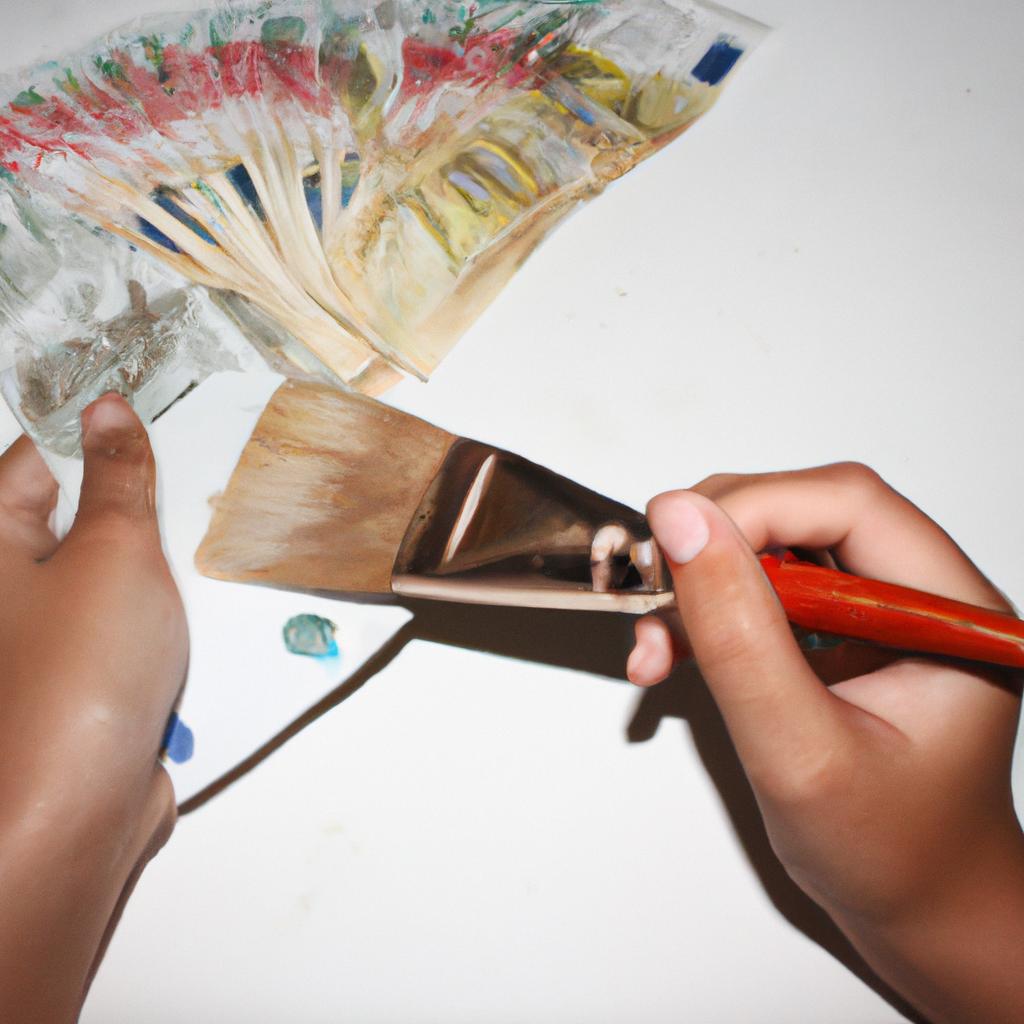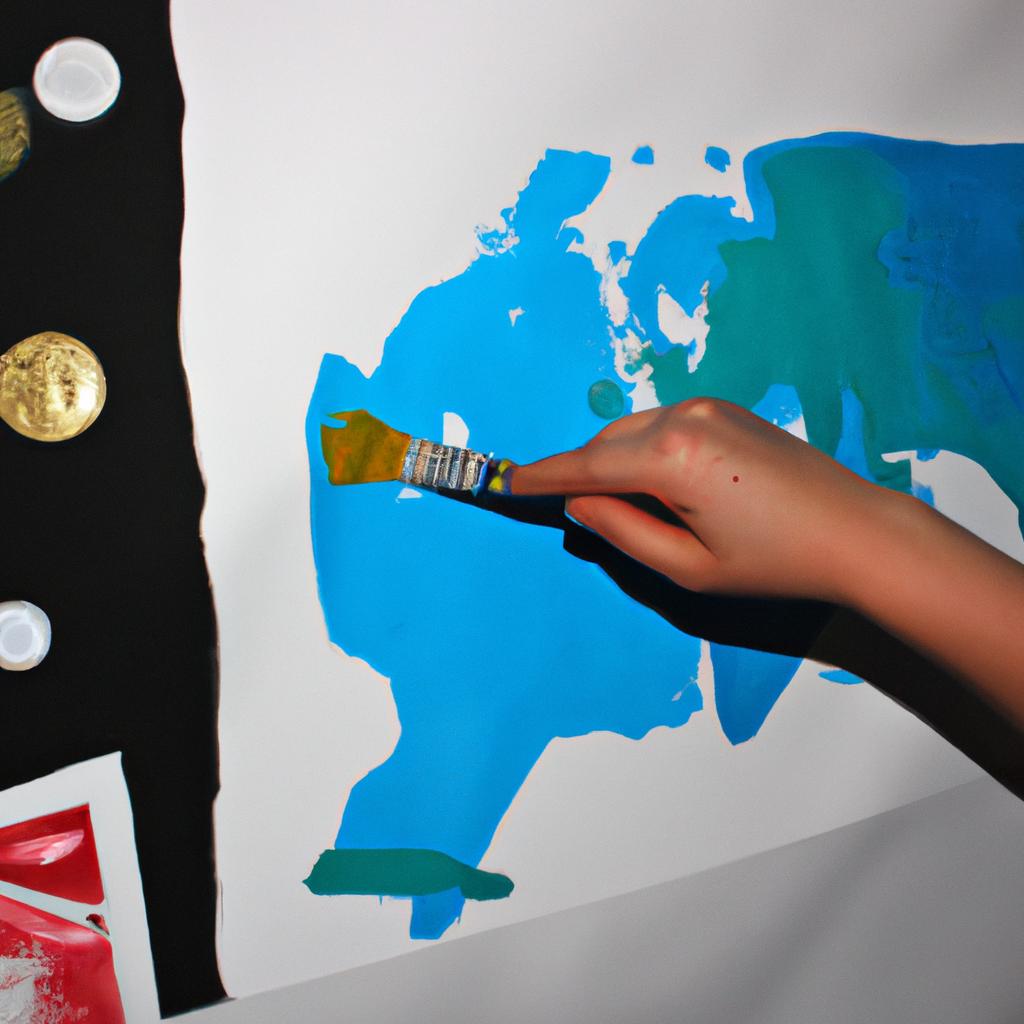Budgeting for creative projects in arts and illustration is a crucial aspect of unleashing the power of creative finance. The ability to effectively manage financial resources plays a significant role in ensuring the successful execution of such projects. For instance, consider a hypothetical case where an artist aims to create a large-scale mural for a public space. In order to bring this vision to life, it becomes imperative for the artist to carefully plan and allocate their budgetary resources towards materials, equipment rentals, labor costs, and any other necessary expenses.
In the realm of arts and illustration, traditional notions of budgeting often confront challenges due to the inherently unpredictable nature of creative processes. Artists are driven by passion and inspiration rather than conventional business models or profit motives; thus, they may find themselves grappling with financial constraints as they strive to transform their ideas into tangible works of art. Consequently, understanding how to navigate these unique circumstances through effective budgeting strategies becomes essential not only for artists themselves but also for organizations supporting artistic endeavors. By adopting innovative approaches that blend creative thinking with sound financial management principles, artists can maximize their potential while mitigating risks associated with budget overruns or inadequate resource allocation. This article delves into the importance of budgeting in creative projects within the arts and illustration field and explores some practical tips and strategies for artists to create and manage budgets effectively.
One key aspect of budgeting for creative projects is conducting thorough research and planning. Artists should carefully consider the scope of their project, identify all necessary expenses, and research the costs associated with each item. This includes materials, equipment, labor, permits, insurance, transportation, marketing/promotion, and any other relevant expenses. By having a clear understanding of these costs upfront, artists can develop a realistic budget that aligns with their vision.
Another important consideration is setting priorities within the budget. Not all aspects of a project may be equally important or require the same level of investment. Artists should evaluate which elements are essential to achieving their artistic goals and allocate resources accordingly. This may involve making trade-offs or finding creative solutions to stretch limited funds.
Additionally, it’s crucial for artists to track their expenses throughout the project’s lifecycle. Keeping detailed records allows for better financial control and helps in identifying areas where adjustments might be needed. Regularly reviewing the budget against actual spending enables artists to stay on track and make informed decisions if any unforeseen circumstances arise.
Collaboration and seeking professional advice can also be beneficial when budgeting for creative projects. Engaging with fellow artists or industry experts who have experience in managing budgets can provide valuable insights and guidance. They may offer suggestions on cost-saving measures or alternative funding sources that could help alleviate financial pressures.
Lastly, flexibility is key when it comes to budgeting in creative projects. Unexpected opportunities or challenges may arise during the course of a project that require adjustments to the original budget. Being open-minded and adaptable allows artists to seize new possibilities while still maintaining financial stability.
In conclusion, effective budgeting is vital for successful execution of creative projects in arts and illustration. By conducting thorough research, setting priorities, tracking expenses diligently, seeking collaboration/advice, and embracing flexibility, artists can unleash the power of creative finance to bring their artistic visions to life.
Identifying project goals and objectives
When embarking on a creative project in arts and illustration, it is crucial to first identify the goals and objectives that will guide the entire process. This initial step sets the foundation for effective budgeting and ensures alignment with the desired outcomes. To illustrate this point, consider the case study of an aspiring illustrator who wants to create a series of illustrations for a children’s book. Their goal might be to evoke a sense of wonder and imagination among young readers while promoting literacy skills.
To begin, it is essential to clearly define the overarching goal of the project. In our case study, this would involve creating visually captivating illustrations that engage children and enhance their reading experience. The next step is to break down this broader objective into specific measurable targets or milestones. For example, these could include completing a certain number of illustrations per week or achieving a particular aesthetic style consistent with the vision for the book.
Achieving project goals requires careful planning and organization. One effective approach is to develop a comprehensive list of tasks necessary to accomplish each milestone. By breaking down larger objectives into smaller, manageable steps, artists can maintain focus throughout the process and track progress effectively. Some key activities may include conducting research on relevant themes or subjects, sketching preliminary ideas, refining drawings through iterative feedback loops, and finalizing artwork for publication.
Incorporating bullet points as follows:
- Enhancing engagement: Captivating illustrations that spark curiosity
- Promoting literacy skills: Creating visuals that encourage reading
- Evoking wonder: Fostering imagination through artistry
- Achieving consistency: Establishing an aesthetic style coherent with the vision
Additionally, employing tables can help visualize vital information concisely:
| Task | Description | Timeline |
|---|---|---|
| Research | Gather inspiration from existing literature | Week 1 |
| Sketching | Develop initial concepts and compositions | Week 2 |
| Feedback and iteration | Refine drawings based on critique and suggestions | Weeks 3-4 |
| Finalizing artwork for publication | Prepare illustrations for print or digital distribution | Weeks 5-6 |
By setting clear goals, breaking them down into actionable steps, and visualizing the process through bullet points and tables, artists can effectively plan their creative projects. In doing so, they lay a solid foundation for budgeting by understanding the scope of work required to achieve their objectives. With this groundwork established, we transition seamlessly into estimating project costs and expenses.
Estimating project costs and expenses
Transitioning from the previous section, where we discussed the importance of identifying project goals and objectives, let us now delve into estimating project costs and expenses. To illustrate this process, imagine a scenario where an aspiring illustrator is working on a graphic novel project.
Estimating project costs involves considering various factors that contribute to the overall budget. These can include but are not limited to:
- Materials: The cost of art supplies such as paper, pencils, paints, or digital software.
- Labor: If collaborating with others or hiring assistants for specific tasks.
- Research: Costs associated with gathering reference materials or conducting background research.
- Marketing and promotion: Expenses related to advertising the final product through websites, social media promotions, or printing marketing materials.
To better understand how these factors come together in determining project costs, let’s consider a hypothetical case study:
Case Study:
An illustrator aims to self-publish their graphic novel. They estimate that they will need approximately $2,500 to cover all expenses throughout the production process. This estimation includes $500 for art supplies and equipment, $800 for hiring an assistant during peak workload periods, $300 for researching historical references relevant to the story’s setting, and $900 for marketing efforts including website creation and promotional materials.
As you can see from this example case study, estimating project costs requires careful consideration of various elements involved in bringing creative projects like illustrations or graphic novels to life. By breaking down the different aspects contributing to the budgetary requirements, artists gain greater clarity on how much funding they need before embarking on their ventures.
In our next section about “Researching Funding Options,” we will explore avenues available for artists seeking financial support beyond personal funds or savings accounts. Through comprehensive research and strategic planning, artists can uncover opportunities that align with their creative vision while ensuring financial sustainability for their projects.
Researching funding options
Estimating project costs and expenses is a crucial step in the budgeting process for creative projects in arts and illustration. By accurately determining the financial requirements of your project, you can make informed decisions about resource allocation and funding options. Let’s explore this topic further.
One hypothetical example that illustrates the importance of estimating project costs involves an artist planning to create a series of illustrations for a children’s book. The artist must consider various factors such as materials, equipment, hiring models or subjects, studio rental (if applicable), printing costs, marketing expenses, and any other relevant expenditures. By carefully estimating these costs upfront, the artist can set realistic goals and identify potential funding sources.
When it comes to estimating project costs and expenses, it is essential to consider the following:
- Materials: Determine what art supplies are needed for your project and research their prices.
- Labor: Calculate the hours required for each aspect of your project and factor in fair compensation rates.
- Overheads: Include indirect expenses like utilities, rent, insurance, software subscriptions, etc., into your budget.
- Contingency: Set aside a portion of your budget for unexpected expenses or emergencies.
To visually represent this information, here is a sample table showcasing estimated costs for our hypothetical children’s book illustration project:
| Expense Category | Estimated Cost |
|---|---|
| Art Supplies | $500 |
| Model Hiring | $300 |
| Studio Rental | $200 |
| Printing | $400 |
This table clearly outlines different expense categories along with their respective estimated costs. Such visual aids help artists grasp the overall picture of their financial commitments more effectively.
In summary, estimating project costs and expenses requires careful consideration of all elements involved in bringing your creative vision to life. By conducting thorough research and using tools like tables to organize cost estimates effectively, you can develop an accurate understanding of your financial needs. With this knowledge at hand, you are better equipped to explore funding options and develop a realistic budget for your creative project.
Transitioning into the subsequent section about “Developing a realistic budget,” it is crucial to build upon the estimated costs and expenses by transforming them into an actionable financial plan. By understanding how to allocate resources effectively, artists can ensure that their projects stay on track financially while maintaining the integrity of their artistic vision.
Developing a realistic budget
Having explored various funding options, it is now crucial to develop a realistic budget that aligns with the financial resources available. By understanding how to effectively allocate funds and prioritize expenses, artists and illustrators can ensure their creative projects are both financially viable and successful.
Developing a realistic budget requires careful consideration of all anticipated expenses. For instance, let’s consider the hypothetical case of an illustrator working on a children’s book project. This illustrator would need to account for costs such as art supplies, digital software subscriptions, printing fees, marketing materials, and potentially hiring a graphic designer or editor for assistance. By thoroughly researching these expenses upfront, artists can avoid unexpected financial burdens during the course of their projects.
To further assist in developing a comprehensive budget plan, here are some key factors to consider:
- Identify essential versus non-essential expenses: Prioritize necessary items over discretionary ones.
- Research industry standards: Understand typical pricing structures within the arts and illustration field to set reasonable expectations.
- Allow room for contingencies: Allocate funds for unforeseen circumstances or additional needs that may arise during the project timeline.
- Consider potential income sources: Explore opportunities for generating revenue through sales, commissions, grants, or collaborations.
Considerations when developing your budget:
- Ensuring every dollar is spent wisely
- Balancing artistic vision with financial limitations
- Feeling empowered by taking control of your finances
- Creating a roadmap for achieving your creative goals
To illustrate different expense categories within a budget plan, refer to the following table:
| Category | Estimated Cost ($) | Notes |
|---|---|---|
| Art Supplies | 500 | Includes paints, brushes, paper |
| Printing | 800 | Covers production of physical books |
| Software | 200 (annual) | Adobe Creative Cloud subscription |
| Marketing | 300 | Promotional materials and online advertising |
By developing a realistic budget, artists can effectively manage their financial resources while bringing their creative visions to life. This process involves careful consideration of all anticipated expenses, including essential versus non-essential items and potential income sources.
Transition into subsequent section:
To maintain control over your finances, it is crucial to establish effective systems for tracking and managing project expenses. By implementing these strategies, you can confidently oversee your budget while focusing on the artistic aspects of your creative projects.
Tracking and managing project expenses
Transitioning from the previous section, which emphasized the importance of developing a realistic budget for creative projects, let us now delve into the crucial task of tracking and managing project expenses. To illustrate this process, we will consider the hypothetical case of an independent illustrator working on a children’s book project.
Once a budget has been established, it is essential to consistently track and manage project expenses to ensure financial stability throughout the duration of the endeavor. In our example scenario, the illustrator begins by creating a spreadsheet that documents all anticipated costs such as art supplies, printing fees, marketing expenses, and any additional services required (e.g., editing or proofreading). By diligently recording each expense in this central document, they gain clarity on their financial situation at any given moment.
To effectively manage finances during a creative project, artists can implement several strategies:
- Regularly reviewing expenditures against projected budgets: This practice allows for early identification of potential overspending or areas where adjustments may be necessary.
- Categorizing expenses: Grouping expenses into categories like production costs, promotional materials, or professional development aids easier analysis and decision-making.
- Prioritizing spending: Evaluating which expenses are critical versus discretionary enables artists to allocate resources more efficiently while staying within budgetary constraints.
- Seeking cost-saving opportunities: Exploring options to reduce expenditure without compromising quality or artistic vision can lead to significant savings over time.
| Strategies for Effective Expense Management |
|---|
| * Review expenditures regularly |
| * Categorize expenses |
| * Prioritize spending |
| * Seek cost-saving opportunities |
Incorporating these strategies helps create transparency and discipline when it comes to managing project finances. By utilizing tools such as spreadsheets and undertaking regular reviews of income and expenses, artists can make informed decisions about resource allocation.
As we have explored how diligent expense tracking and management are integral components of successful budget implementation in creative projects, the subsequent section will delve into evaluating the financial success of the project. Understanding this aspect allows artists to make more informed decisions in future endeavors and optimize their financial strategies accordingly.
Evaluating the financial success of the project
Having established effective methods for tracking and managing project expenses, it is essential to evaluate the financial success of a creative project in order to make informed decisions moving forward. This evaluation allows artists and illustrators to identify areas of improvement, measure their return on investment (ROI), and determine whether their financial goals have been met.
Example:
To illustrate this process, let’s consider an example involving a freelance illustrator named Sarah. She recently completed a commissioned artwork for a client and wants to assess its financial performance. By evaluating the project’s monetary outcomes, Sarah can gain valuable insights into her pricing strategy, resource allocation, and overall profitability.
Evaluating the financial success of a creative project involves several key steps:
-
Calculation of total revenue generated: Summing up all income generated by the project provides a clear understanding of its monetary value. This includes not only direct payments received but also any indirect revenue such as licensing deals or print sales linked to the artwork.
-
Comparison with initial budget: Analyzing how actual expenses align with the initially estimated budget enables artists to gauge their cost control effectiveness. By comparing these figures side-by-side, one can identify potential overspending or underspending during different stages of the project.
-
Assessment of ROI: Calculating return on investment helps measure the profitability of a creative endeavor. It involves dividing net profit by total investment (including both monetary inputs and time spent) and expressing it as a percentage. A positive ROI indicates that the artist has achieved satisfactory financial returns on their efforts.
-
Reviewing client feedback and satisfaction: While finances play a crucial role in evaluating success, considering client satisfaction is equally important for long-term growth in artistic careers. Artists should solicit feedback from clients regarding their experience working together, quality delivered, timeliness, and overall satisfaction with the final outcome.
Table Example:
| Evaluation Criteria | Rating (1-5) |
|---|---|
| Revenue generated | 4 |
| Adherence to budget | 3 |
| Return on investment (ROI) | 2.5 |
| Client satisfaction | 4.5 |
Through a comprehensive evaluation process, artists and illustrators can gain valuable insights into the financial outcomes of their creative projects. This allows them to make informed decisions moving forward, identify areas for improvement, and adapt their strategies accordingly. By embracing this evaluative mindset, professionals in the arts and illustration industry can unleash the power of creative finance to achieve long-term success.
Please let me know if there is anything else I can assist you with!
 PSP Oste
PSP Oste



